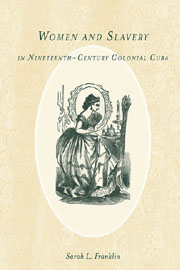Book contents
- Frontmatter
- Contents
- List of Illustrations
- Acknowledgments
- Introduction: Patriarchy, Paternalism, and the Development of the Slave Society
- 1 Virgins and Mothers
- 2 Wives
- 3 Pupils
- 4 The Needy
- 5 Wet Nurses
- Conclusion: A Shifting Landscape
- Abbreviations
- Notes
- Bibliography
- Index
- Rochester Studies in African History and the Diaspora
Introduction: Patriarchy, Paternalism, and the Development of the Slave Society
Published online by Cambridge University Press: 05 February 2013
- Frontmatter
- Contents
- List of Illustrations
- Acknowledgments
- Introduction: Patriarchy, Paternalism, and the Development of the Slave Society
- 1 Virgins and Mothers
- 2 Wives
- 3 Pupils
- 4 The Needy
- 5 Wet Nurses
- Conclusion: A Shifting Landscape
- Abbreviations
- Notes
- Bibliography
- Index
- Rochester Studies in African History and the Diaspora
Summary
On the night of December 14, 1807, in San Miguel, Cuba, just outside Havana, Doña Teresa Días left home. She ran away, taking all her clothes with her, and moved in with Don Marcos Valentín. Her husband, Don Dionsio de Meza was angry, so angry that he complained to a local government official. Teresa's actions were a direct affront to the social and cultural norms and precepts of nineteenth-century Cuba. The state viewed the matter gravely as evidenced by its actions; it took Teresa into custody and “deposited” her in a house that met with government approval. Local officials sought the advice of the captain general, Cuba's highest official, who ordered the parameters of the case be presented to a tribunal that would render judgment in the matter.
Although such a course of action may seem quite remarkable today, there was nothing exceptional about it in Cuba in 1807. Women in nineteenth-century Cuba lived under a hierarchical structure employed to create and maintain the slave society. Those at the top of that structure recognized that the escalation and perpetuation of the Cuban slave society required a rigid social hierarchy based on race, gender, and legal status, and they employed patriarchy to achieve that end. The white men who dominated Cuba in the interconnected arenas of politics, business, and religion did not create patriarchy out of whole cloth, but they did shape it to fit local demands.
- Type
- Chapter
- Information
- Publisher: Boydell & BrewerPrint publication year: 2012



